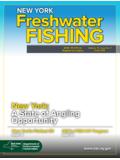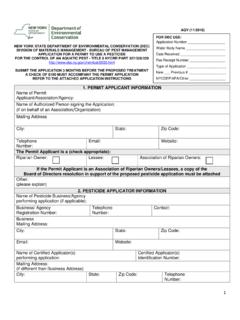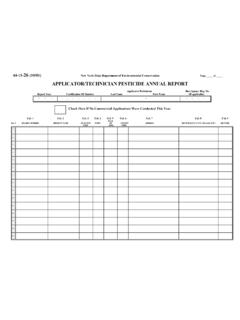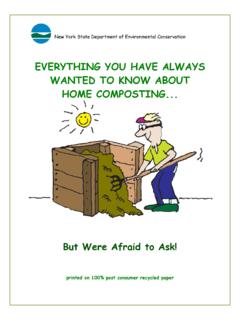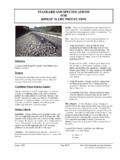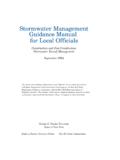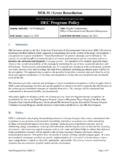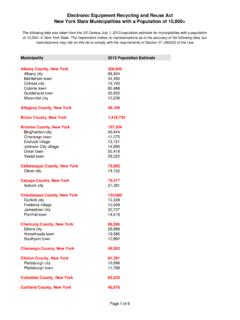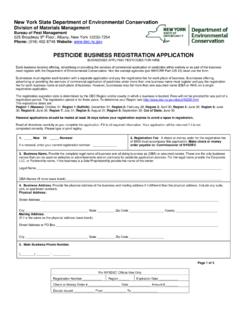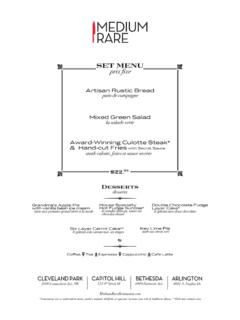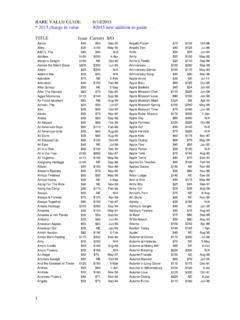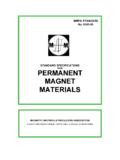Transcription of New York Rare Plant Status Lists November 2017
1 New york Rare Plant Status List May 2003 Edited by Stephen M. Young and Troy W. Weldy New york Natural Heritage Program A Partnership between SUNY ESF and the NYS Department of Environmental Conservation 625 Broadway, 5th Floor, Albany, NY 12233-4757 (518) 402-8935 Fax (518) 402-8925 New york Rare Plant Status ListsNovember 2017 Compiled by Stephen M. Young Green Milkweed Asclepias viridiflora New york Natural Heritage Program Rare Plant Status Lists November 2017 Compiled by: Stephen M. YoungThis list and a sortable table are also published at the website: Conservation Guides for most species are available at: information is available about all the plants at: more information, suggestions or comments about this list, please contact: Stephen M.
2 Young, Chief Botanist New york Natural Heritage Program 625 Broadway, 5th Floor Albany, NY 12233-4757 518-402-8951 Fax 518-402-8925E-mail: report sightings of rare species, contact our office or fill out the online rare species reporting form at in 1985, the New york Natural Heritage Program (NYNHP) is a program of the State University of New york College of Environmental Science and Forestry (SUNY ESF). The Program is funded by grants and contracts from government agencies whose missions involve natural resource management, private organizations involved in land protection and stewardship, and both government and private organizations interested in advancing the conservation of biodiversity.
3 The NYNHP Botany Program, including the production of this Rare Plant Status List, is made possible by the New york State Environmental Protection Fund, the New york State Department of Environmental Conservation and the New york State Office of Parks, Recreation and Historic Preservation. New york Natural Heritage Program Page i TABLE OF CONTENTS Introduction .. Page ii Why are the Lists published? What are the Lists and what do they contain? How is the information compiled? How do the Lists change? Why are plants rare? Why protect rare plants ? Explanation of categories .. Page iv Explanation of Heritage ranks and codes.
4 Page iv Global rank State rank Taxon rank Double ranks Explanation of Plant legal Status .. Page v Federal legal Status New york State legal Status Acknowledgements .. Page vii Changes since the June 2010 rare Plant Status list .. Page viii Rare Plant active inventory list (alphabetical by species) .. Page 1 Rare Plant watch list (alphabetical by species) .. Page 39 Native pioneer plants watch list .. Page 49 Rare Plant review list .. Page 50 Rare Plant phenology list .. Appendix I: Page 53 County map Cover photo: Green Milkweed, Asclepias viridiflora, by Stephen Young. This report should be cited as: Young, Stephen M.
5 2017. New york Rare Plant Status Lists . New york Natural Heritage Program, New york State Department of Environmental Conservation, Albany, NY. November 2017. 103 pp. New york Natural Heritage Program Page ii New york Natural Heritage Program Rare Plant Status Lists WHY ARE THE Lists PUBLISHED? The New york Natural Heritage Program publishes the rare Plant Status Lists : assist the conservation and protection efforts of government agencies, private organizations, and thegeneral public, provide information for use in the environmental review process, provide information to educators and researchers about New york 's rare plants , assist those in search of rare ARE THE Lists AND WHAT DO THEY CONTAIN?
6 The Active Inventory List - This list contains the name, Heritage rank, counties of occurrence, and state legal Status for 587 plants that the NY Natural Heritage Program actively tracks and surveys. It contains Plant taxa (species, subspecies and varieties) that are ranked S1 to S2S3 in the state and are considered highly vulnerable to extirpation. It also includes four species that are ranked S3 but are also globally rare and have most of their global occurrences in New york (Bidens bidentoides, Polemonium vanbruntiae, Polygonum glaucum, and Trollius laxus). Active List species have been documented by a Heritage survey or other documenting information, like an herbarium specimen or photograph, in the last 30 years (Extant=456 taxa).
7 It also contains rare historical taxa, those plants that were documented over 30 years ago (SH=70 taxa), and the extirpated taxa, those that are considered no longer extant in the state (SX=61 taxa). The Watch List - This contains the same fields as the active list for 89 plants . The list contains native species that are ranked S3 to S4 and considered rare, uncommon, or declining in numbers and need continued periodic monitoring to decide if they should be actively inventoried or removed from the list. plants are listed on the watch list when they have 21-34 occurrences and 10 of those occurrences were ranked excellent or good in the last 30 years.
8 They are also listed on the watch list if they have 35 or more occurrences and fewer than 10 occurrences ranked excellent or good in the last 30 years or the number of plants are in steep decline. They may also be on the watch list if they have fewer than 21 occurrences but more than a total of 10,000 plants statewide and those numbers are stable or increasing. The Native Pioneer plants Watch List- This contains the same fields as the active list for 2 plants . The list contains native species that are ranked S1 to S2S3 but are considered pioneer species, or weedy in nature, and predicted to increase in numbers over time.
9 They are usually recent additions to the state and are actively colonizing disturbed sites. They also need continued periodic monitoring to decide if they should be actively inventoried as a rare native Plant or removed from the list as numbers increase The Review List This contains species that may be rare within New york , but more work is needed to determine their distribution within the state, resolve taxonomic/identification problems, etc. before their state rarity can be determined. New york Natural Heritage Program Page iii HOW IS THE INFORMATION COMPILED? These Lists have been compiled over many years from a variety of sources.
10 By consolidating these sources, NY Natural Heritage is able to enhance their usefulness and identify gaps in knowledge. Information is gathered principally from fieldwork as well as from published and unpublished reports, herbarium specimens, and oral reports. When occurrences of rare plants are discovered in the field, quantity of individuals, quality, and location of the population are documented, and, if warranted, specimens and/or photographs are taken. These occurrences are then monitored, and changes in biology and land conservation Status are recorded. Information gathered from all sources is mapped on a GIS (Geographical Information System) and entered into a database that serves as a "communal memory" of rare Plant , animal, and natural community information from across the state.
